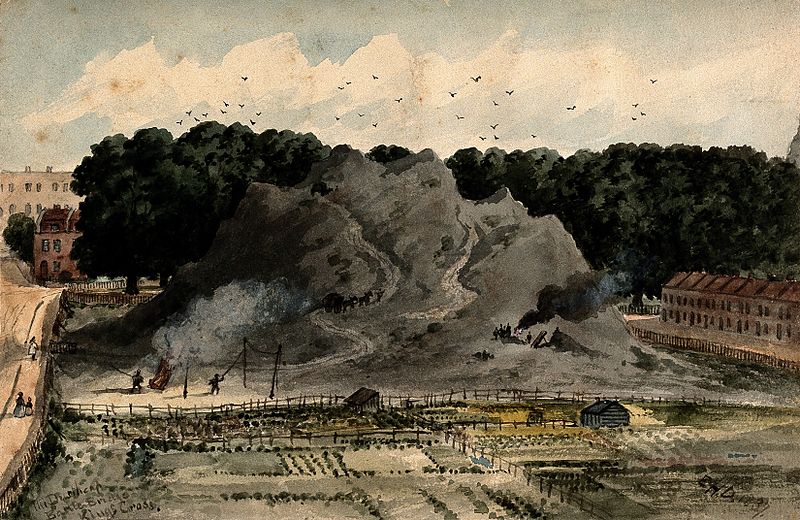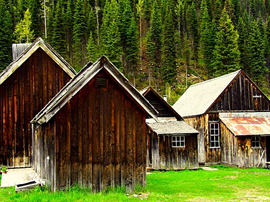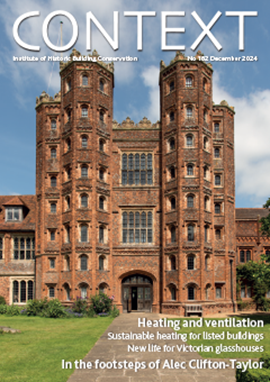Dust heap
|
This watercolour painting depicts King's Cross, London: the Great Dust Heap, next to Battle Bridge and the Smallpox Hospital by E H Dixon (1837). Notations associated with the painting describe it as a ‘View of the Great Dust Heap, King’s Cross, Battle Bridge, from the Maiden Lane (the present York Road). It was removed in 1848 to assist in rebuilding the City of Moscow, Russia.’ |
Contents |
[edit] Introduction
Dust heaps were human-made mountains of ash, cinders and combustible domestic waste or soil that accumulated around London during the 19th century. These piles of fine dust, clinker, breeze (or brieze) and other household rubbish were created by the large amounts of coal used in London from roughly 1800 to 1850. During this period, it was thought that each London household used as much as 11 tons of coal annually for domestic fires.
[edit] Early waste collection method
This form of waste management was initially instituted for practical safety purposes. It was thought that the large quantity of ash residue - if left uncollected - would block passageways and create other hazards in London.
To combat the safety issue of unmanaged household waste - which was also becoming a public eyesore - communities employed dust contractors who would be hired to collect and transport the material to the dust heaps on the outskirts of the city. For those in the dust collection market, this became a lucrative business, since the materials held varying degrees of value once separated out by labourers known as sifters or scavengers.
Domestic waste (or soil) was sold to farmers for manure. Cinders, ash, clinker and breeze were sold to brickmakers (as fuel for burning and material for making building materials; this is the origin of the terms breezeblock - or briezeblock - and cinderblock in the US). Other salvageable items (such as discarded pans and pottery) were also recovered and set aside for possible sale or reuse.
[edit] The Great Dust Heap of King’s Cross
Dust heaps were a fixture in London during Victorian times. In Our Mutual Friend by Charles Dickens, dust heaps were the source of wealth for Nicodemus (Noddy) Boffin, a lowly clerk who inherits several dust heaps from his employer and becomes The Golden Dustman. These vast piles were extremely valuable, but when it became necessary to address public sanitation issues in the 1850s, the phase out process began.
One of the most valuable and extensive of these sites in London was the Great Dust Heap. In 1848, this vast mountain was removed to make way for King’s Cross Station (which was part of the newly commissioned Great Northern Railway).
According to Vic Keegan’s Lost London 109: The Great Dust Heap, “Contemporary accounts – including W J Pinks’s venerable survey of Clerkenwell – report that the dust heap was sold – wait for it – to the government of Russia to help the re-building of Moscow after the war with Napoleon for an estimated price of £20,000.”
[edit] Related articles on Designing Buildings
- A heritage partnership agreement for King's Cross Station.
- Blockwork.
- Civil Engineering during the Industrial Revolution in Britain.
- Clinker in construction.
- Coal ash.
- Environmental engineering.
- King's Cross Station Redevelopment.
- Miasma theory.
- Three pieces of infrastructure that have saved lives.
- Waste management - explained.
[edit] External resources
- Victor Keegan, On London, Lost London 109: The Great Dust Heap.
IHBC NewsBlog
IHBC Annual School 2025 - Shrewsbury 12-14 June
Themed Heritage in Context – Value: Plan: Change, join in-person or online.
200th Anniversary Celebration of the Modern Railway Planned
The Stockton & Darlington Railway opened on September 27, 1825.
Competence Framework Launched for Sustainability in the Built Environment
The Construction Industry Council (CIC) and the Edge have jointly published the framework.
Historic England Launches Wellbeing Strategy for Heritage
Whether through visiting, volunteering, learning or creative practice, engaging with heritage can strengthen confidence, resilience, hope and social connections.
National Trust for Canada’s Review of 2024
Great Saves & Worst Losses Highlighted
IHBC's SelfStarter Website Undergoes Refresh
New updates and resources for emerging conservation professionals.
‘Behind the Scenes’ podcast on St. Pauls Cathedral Published
Experience the inside track on one of the world’s best known places of worship and visitor attractions.
National Audit Office (NAO) says Government building maintenance backlog is at least £49 billion
The public spending watchdog will need to consider the best way to manage its assets to bring property condition to a satisfactory level.
IHBC Publishes C182 focused on Heating and Ventilation
The latest issue of Context explores sustainable heating for listed buildings and more.
Notre-Dame Cathedral of Paris reopening: 7-8 December
The reopening is in time for Christmas 2025.

















